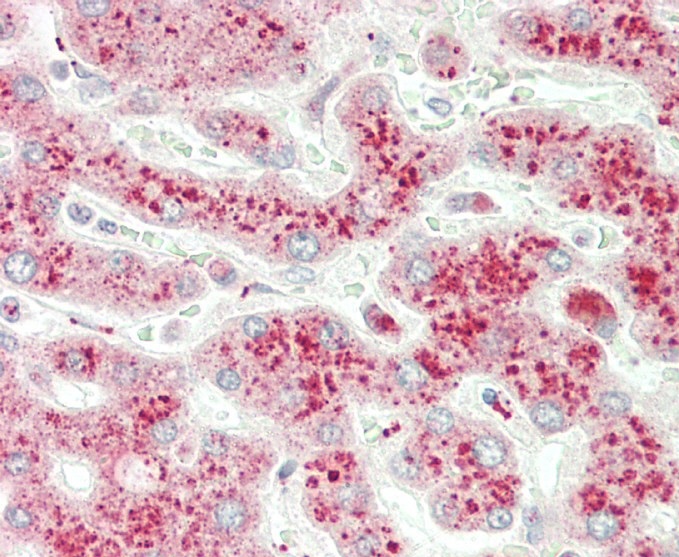NMNAT3 Antibody (Center)
Affinity Purified Rabbit Polyclonal Antibody (Pab)
- SPECIFICATION
- CITATIONS
- PROTOCOLS
- BACKGROUND

Application
| WB, IHC-P, E |
|---|---|
| Primary Accession | Q96T66 |
| Other Accession | NP_835471.1 |
| Reactivity | Human |
| Host | Rabbit |
| Clonality | Polyclonal |
| Isotype | Rabbit IgG |
| Calculated MW | 28322 Da |
| Antigen Region | 150-178 aa |
| Gene ID | 349565 |
|---|---|
| Other Names | Nicotinamide mononucleotide adenylyltransferase 3, NMN adenylyltransferase 3, Nicotinate-nucleotide adenylyltransferase 3, NaMN adenylyltransferase 3, Pyridine nucleotide adenylyltransferase 3, PNAT-3, NMNAT3 |
| Target/Specificity | This NMNAT3 antibody is generated from rabbits immunized with a KLH conjugated synthetic peptide between 150-178 amino acids from the Central region of human NMNAT3. |
| Dilution | WB~~1:1000 IHC-P~~1:100 E~~Use at an assay dependent concentration. |
| Format | Purified polyclonal antibody supplied in PBS with 0.09% (W/V) sodium azide. This antibody is purified through a protein A column, followed by peptide affinity purification. |
| Storage | Maintain refrigerated at 2-8°C for up to 2 weeks. For long term storage store at -20°C in small aliquots to prevent freeze-thaw cycles. |
| Precautions | NMNAT3 Antibody (Center) is for research use only and not for use in diagnostic or therapeutic procedures. |
| Name | NMNAT3 (HGNC:20989) |
|---|---|
| Function | Catalyzes the formation of NAD(+) from nicotinamide mononucleotide (NMN) and ATP (PubMed:16118205, PubMed:17402747, PubMed:26616331). Can also use the deamidated form; nicotinic acid mononucleotide (NaMN) as substrate with the same efficiency. Can use triazofurin monophosphate (TrMP) as substrate. Can also use GTP and ITP as nucleotide donors. Also catalyzes the reverse reaction, i.e. the pyrophosphorolytic cleavage of NAD(+). For the pyrophosphorolytic activity, can use NAD(+), NADH, NaAD, nicotinic acid adenine dinucleotide phosphate (NHD), nicotinamide guanine dinucleotide (NGD) as substrates. Fails to cleave phosphorylated dinucleotides NADP(+), NADPH and NaADP(+). Protects against axonal degeneration following injury (PubMed:16118205, PubMed:17402747). May be involved in the maintenance of axonal integrity (By similarity). Also functions as a stress-response chaperone protein that prevents toxic aggregation of proteins; this function may be independent of its NAD(+) synthesis activity (PubMed:18344983). |
| Cellular Location | Mitochondrion |
| Tissue Location | Expressed in lung and spleen with lower levels in placenta and kidney. |

Thousands of laboratories across the world have published research that depended on the performance of antibodies from Abcepta to advance their research. Check out links to articles that cite our products in major peer-reviewed journals, organized by research category.
info@abcepta.com, and receive a free "I Love Antibodies" mug.
Provided below are standard protocols that you may find useful for product applications.
Background
The coenzyme NAD and its derivatives are involved in hundreds of metabolic redox reactions and are utilized in protein ADP-ribosylation, histone deacetylation, and in some Ca(2+) signaling pathways. NMNAT (EC 2.7.7.1) is a central enzyme in NAD biosynthesis, catalyzing the condensation of nicotinamide mononucleotide (NMN) or nicotinic acid mononucleotide (NaMN) with the AMP moiety of ATP to form NAD or NaAD (Zhang et al., 2003 [PubMed 12574164]).
References
Di Stefano, M., et al. Blood Cells Mol. Dis. 45(1):33-39(2010)
Lau, C., et al. J. Biol. Chem. 285(24):18868-18876(2010)
Sorci, L., et al. Biochemistry 46(16):4912-4922(2007)
Berger, F., et al. J. Biol. Chem. 280(43):36334-36341(2005)
Magni, G., et al. Cell. Mol. Life Sci. 61(1):19-34(2004)
If you have used an Abcepta product and would like to share how it has performed, please click on the "Submit Review" button and provide the requested information. Our staff will examine and post your review and contact you if needed.
If you have any additional inquiries please email technical services at tech@abcepta.com.













 Foundational characteristics of cancer include proliferation, angiogenesis, migration, evasion of apoptosis, and cellular immortality. Find key markers for these cellular processes and antibodies to detect them.
Foundational characteristics of cancer include proliferation, angiogenesis, migration, evasion of apoptosis, and cellular immortality. Find key markers for these cellular processes and antibodies to detect them. The SUMOplot™ Analysis Program predicts and scores sumoylation sites in your protein. SUMOylation is a post-translational modification involved in various cellular processes, such as nuclear-cytosolic transport, transcriptional regulation, apoptosis, protein stability, response to stress, and progression through the cell cycle.
The SUMOplot™ Analysis Program predicts and scores sumoylation sites in your protein. SUMOylation is a post-translational modification involved in various cellular processes, such as nuclear-cytosolic transport, transcriptional regulation, apoptosis, protein stability, response to stress, and progression through the cell cycle. The Autophagy Receptor Motif Plotter predicts and scores autophagy receptor binding sites in your protein. Identifying proteins connected to this pathway is critical to understanding the role of autophagy in physiological as well as pathological processes such as development, differentiation, neurodegenerative diseases, stress, infection, and cancer.
The Autophagy Receptor Motif Plotter predicts and scores autophagy receptor binding sites in your protein. Identifying proteins connected to this pathway is critical to understanding the role of autophagy in physiological as well as pathological processes such as development, differentiation, neurodegenerative diseases, stress, infection, and cancer.




